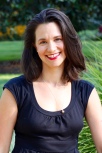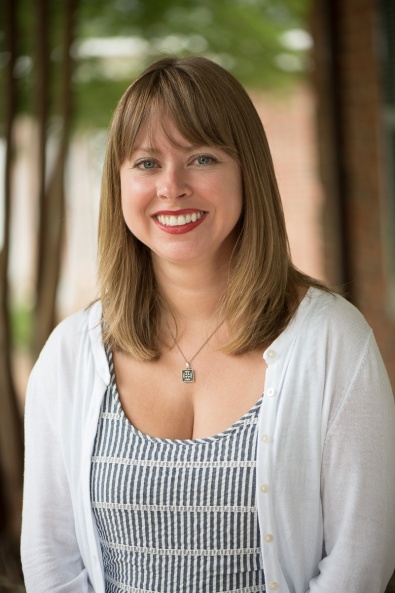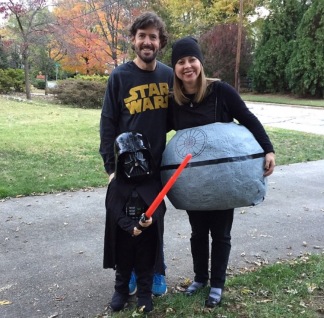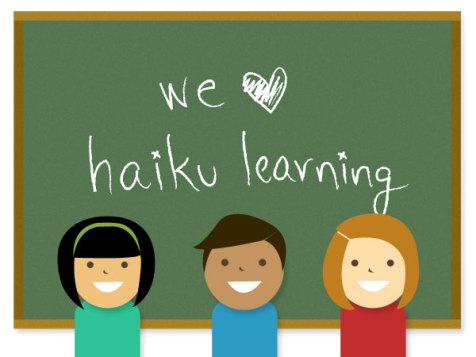As a new Canterbury parent, I was wondering where the Library is located. After speaking with Canterbury Media Specialist Kari Baumann, I now know that the answer is: all over campus! Kari believes that the Library is more than just a place to check out books. Fully immersed in 21st century learning, Canterbury students have the opportunity to learn in ways that integrate technology and print media. As Kari puts it, “I like to think of the Library not only as a physical space but also as a hub from which information moves. I have seen how naturally technology folds into a passion for reading and information as we synthesize, organize, and present the materials we are learning and reading together, and I enjoy using both of them together.”
A North Carolina native, Kari spent most of her childhood about 45 minutes south of Greensboro, in Siler City. Her dad passed away in 2006, and her mom remarried this past summer. Her brother and his family live in Austin, Texas. Kari and Mike — her husband of 15 years —make their home in Greensboro with their 4 ½ year old son Atticus.
After earning a bachelor’s degree in Marketing and Economics, Kari identified her passion for books and information and went on to earn a master’s degree in Library Science at The University of North Carolina at Greensboro. Following some time working in a public library, Kari returned to school to obtain her education license and has worked as a media specialist for the past eight years. She is thrilled to join the Canterbury faculty this year, and is looking forward to getting to know the Canterbury community.
When asked about her typical Canterbury day, Kari responds, “One of the very best things about being a librarian is that every day is different! You never know what questions will come up and what you will be doing.” She plans to bring the Library to Canterbury students through iPads as well as her bookmobile, which will make its way into the divisions. She also will assist Canterbury teachers with Haiku and integrating technology into their instruction.
I couldn’t resist asking Kari to name her favorite children’s book. Her response? Quite cruel to ask a librarian to choose just one. Instead, she listed a few of her favorites: Board book – I am a Bunny by Richard Scarry
Kindergarten – The Book With No Pictures by B.J. Novak
2nd grade – Sideways Stories from Wayside School by Louis Sachar
5th grade – The Wednesday Wars by Gary D. Schmidt
8th grade – Speak by Laurie Halse Anderson
Even as the Library can be found everywhere at Canterbury, it will also continue to exist as a space for students to come browse and check out books. How about one of the recommendations above?
More Kari Baumann favorites:
Favorite foods: Mexican food and salty snacks.
Favorite hobby: Reading, of course
Favorite travel destination: My husband and I have taken two trips to Prince Edward Island in Canada (home of Anne of Green Gables) and we hope to take our son there in a few years.
Favorite music: A few favorites are Josh Ritter, Patty Griffin, The Head and the Heart, Over the Rhine, and Brandi Carlile.
Favorite book: Pride and Prejudice by Jane Austen
Favorite author: Madeleine L’Engle
by Emily Wilson Brenner
 Emily Wilson Brenner is parent to Benjamin (PreK-Copeland/Kaplan) and Fritz, wife to Kevin, a dance artist, and an instructor in Canterbury’s PreK Afternoon Adventures. Her favorite thing about Canterbury is the beautifully inspiring outdoor space. She likes yoga, dark chocolate, and a good cup of green tea.
Emily Wilson Brenner is parent to Benjamin (PreK-Copeland/Kaplan) and Fritz, wife to Kevin, a dance artist, and an instructor in Canterbury’s PreK Afternoon Adventures. Her favorite thing about Canterbury is the beautifully inspiring outdoor space. She likes yoga, dark chocolate, and a good cup of green tea.



